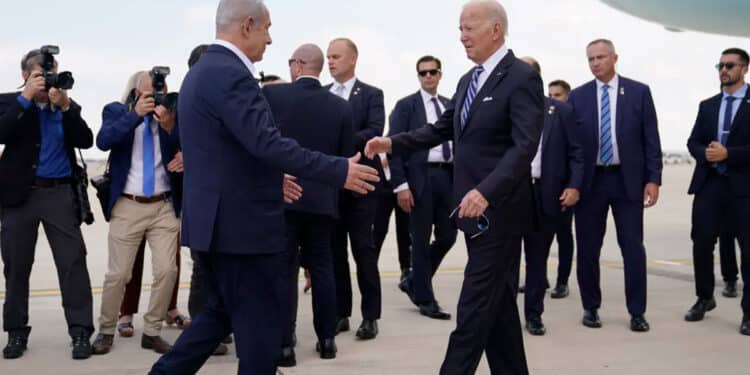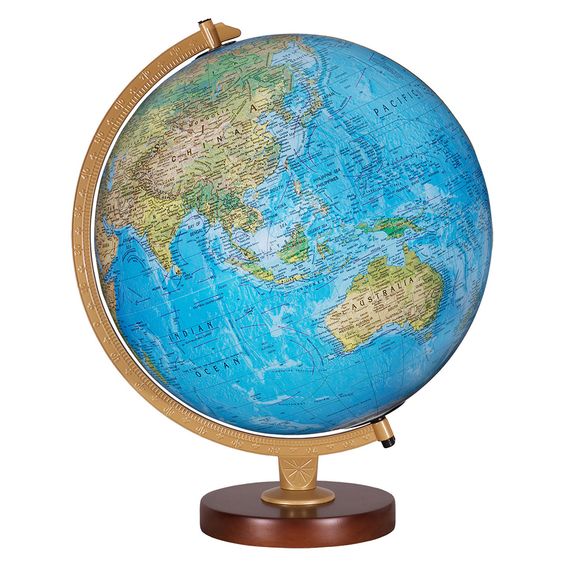
Roughly 2.2 million Gazans have been without electricity, water, medicine or other vital supplies since the attack.
By Tom Arms
An American-led offensive is desperately trying to thread a narrow diplomatic needle and prevent the Gaza Crisis from exploding into an uncontrollable wider war.
Joe Biden, Olof Scholz and Rishi Sunak have all been to Israel this week. Emmanuel Macron and Giorgia Meloni will soon follow.
Together they are known as “The Quint” and they are all preaching the same message: 1- Support for Israel and its right to defend itself. 2- Total condemnation of Hamas. 3- The need to differentiate between Hamas and Palestinians. 4- The urgent need for humanitarian aid to reach Gaza residents 5- Prevent the red mist from blinding Israel to the wider consequences of a no-holds barred invasion of Gaza. 6- Deter Iran.
The foundational premise of the diplomatic offensive is that American support for Israel is granite-like. The oppressive security-heavy policies of successive Likud-led governments has chipped away at American backing. But the American-buttressed plinth on which Israel sits is so large that it is unlikely to ever be reduced to rubble.
Alongside Israeli over-reaction is the associated problem of Iran’s reaction to the Gaza crisis. Its foreign minister (Hossein Amir Abdollahian) has threatened to activate the “Axis of Resistance” if Israeli forces move into Gaza. In fact, Tehran may have already done so. On Thursday the American warship USS Carney intercepted Israeli-bound missiles fired by Yemen’s Iranian-backed Houthi rebels. US troops in Syria and Iraq have suffered drone attacks and Hezbollah has launched missile attacks from southern Lebanon.
In response to the Iranian threat, the US has moved two aircraft carriers into the eastern Mediterranean and 2,000 additional troops into the region. Washington said they are meant as a deterrent.

On the diplomatic front, Washington is relying mainly on Qatar to act as a go-between. The Gulf kingdom has good relations with Hamas, Hezbollah and Iran as well as playing host to 10,000 American troops.
Japan, which has reasonable diplomatic relations with Tehran, has also offered its services.
The immediate focus of the Western countries is humanitarian aid to Gaza. This is a signal to the Arab countries that while condemning Hamas, they do not hold the Palestinians as a whole responsible for their actions. President Biden has pledged $100 million. The EU has trebled its assistance to Gaza to $75 million and the UK has increased its aid to $12.8 million. Canada and Japan have upped their aid to $10 million each and Australia is sending $32.4 million in aid to Gaza
But increased aid and the food and medicines it buys are useless if they fail to reach the intended recipients. To do this, the Israeli-imposed blockade had to be lifted. Roughly 2.2 million Gazans have been without electricity, water, medicine or other vital supplies since the attack. After what American diplomats described as “frank discussions”, Netanyahu’s office announced that it “would not foil the supply of humanitarian aid via Egypt.”
However, the aid will be little and possibly too late for many Gazans. Since October 7 the Israel Air Force has been bombing the Rafah Crossing which links Egypt and Gaza. It is now impassable. Twenty Lorries filled with essential supplies are expected to cross into Gaza on Friday. Up to 200 are waiting. According to the UN Relief Agency, at least a 100 are needed every day.
Resuming the aid flow is only one step towards threading the diplomatic needle. As well as deterring an Iranian-backed Hezbollah attack, the US must persuade the Israeli Defence Force to tread softly as they invade Gaza.
This will be difficult. Gaza is one of the most densely populated areas in the world. The Israelis are refusing to allow civilians to leave and the Egyptians are adamant that they will turn away any refugees.
Urban fighting is the most difficult and dangerous there is. Every wall is a defensive shield. Complicating the logistics is a complex web of tunnels which will doubtless be booby-trapped and in which are probably kept 199 Israeli hostages.
The aim of the Israeli Defence Force is to free the hostages, destroy Hamas as a military and political force and to do so with the absolute minimum of “collateral damage” to the large, overcrowded and trapped civilian population. Failure to achieve those nigh impossible military aims runs the risk of a Hezbollah/Iranian attack which could ignite the entire region.
IF (note capital letters) aid is restored, Iran deterred and Israel held in check, Washington faces the even more difficult “what next” problem. Returning to America on Air Force One, President Biden spoke of reviving the moribund two-state solution. That is a discussion for tomorrow.
 World Review
World Review
Russian President Vladimir Putin must be delighted by the Gaza Crisis.
It ticks a number of Moscow’s foreign policy boxes. For a start, it distracts the world from his war crimes in Ukraine and allows him to point the blame finger at America’s absolute support for Israel.
Russia’s Middle East policy is complicated. It supports Bashar al-Assad in Syria, but Putin also has a close personal relationship with Israeli Prime Minister Benjamin Netanyahu. He has used that relationship to stop Israel from sending weapons to Ukraine.
Russia has also refused to go along with most of the rest of the world in branding Hamas as a terrorist organization. In fact, Hamas leaders make regular visits to Moscow and American intelligence believes that the Wagner Group has been training Hamas fighters at Russian bases in Syria.
Then there is Iran—a clear link between Hamas and Hezbollah on the one hand and Russia on the other. The common enemy of America means close Iranian-Russian relations. There is a constant flow of Iranian drones and other weaponry to Russia, Gaza and Hezbollah fighters in Iraq, Syria and Lebanon.
Joe Biden and Xi Jinping agree on something—the revival of the two-state solution as the only practical long-term way out of the Palestinian conundrum.
The agreed concept of separate Palestinian and Israeli states was the major achievement of the 1993 Oslo Accords agreed by Yasser Arafat and Yitzhak Rabin. Then Rabin was assassinated; Netanyahu came to power in Israel; Donald Trump entered the White House; the two-state solution was dropped and the Palestinian cause was swept under the carpet for the world to trip over in October 2023.
On his return journey to America, President Biden told journalists that it was time to revive the moribund Oslo Accords. And in Beijing, Xi Jinping said, after a meeting with the Egyptian prime minister, that the two-state solution is “the fundamental way out.”
The stumbling block is Israel’s Likud-led coalition. Netanyahu has for years persuaded Israeli voters that they can have it all—security and the absence of a troublesome Palestinian state. His position has been strengthened by the inclusion in the cabinet of the ultra-Orthodox parties who demand the ejection of Palestinians and the re-establishment of the Eretz Israel of the Old Testament.
The Hamas attack has dispelled the myth that long-term security is possible without a political settlement with the Palestinians. But Israeli voters will still need to be persuaded.
The right-wing of the Republican Party supports urgent aid to Israel. The left-wing of the Democratic Party opposes it.
The Democratic Party as a whole supports urgent aid to Ukraine. The right-wing of the Republican Party opposes it.
All spending bills have to be approved by the House of Representatives, which, at the moment, is not functioning because it is deadlocked over its election of a Speaker.
And finally the dual disaster of Iraq and Afghanistan have pushed many American voters back into their isolationist shell.
To deal with the growing isolationism and the difference of aid disbursement, President Joe Biden addressed the nation on Friday night. He told voters that “history has taught us when terrorists don’t pay a price for their terror, when dictators don’t pay a price for their aggression, they cause more chaos and death and more destruction. They keep going and the cost and the threat to America and the world keeps rising.”
To address the partisan differences over aid disbursement, Biden proposed one large aid package for both Israel and Ukraine and put them both in a single spending bill. Then, to make it more palatable, he included cash for Taiwan—a policy supported by both parties. Right-wing Republicans cannot vote for money for Israel without also voting to support Ukraine.
However, the problem of a deadlocked House of Representatives remains. Far-right Congressman Jim Jordan is persistent in his determination to secure the Speaker’s chair. This is despite a growing trickle of Republican votes away from his candidacy.
His decision to push for a third ballot came after conservative Republicans blocked a proposal to empower the Speaker Pro-Tempore, Congressman Patrick McHenry, to handle the legislative agenda until January. This would allow the House to vote on Biden’s Ukraine/Israel/Taiwan aid package as well as heading off—hopefully—a threatened government shutdown from 17 November.
Hope for Ukraine and Israel lies with a third ballot being held quickly; Jordan giving up and Patrick McHenry assuming temporary powers.
Poland has demonstrated that the political drift to the right is not inevitable. In the past year, European conservatives have won general elections in Hungary, Turkey and Slovakia. German conservatives are also increasing their share of the Lander vote and the far-right AfD (Alternative for Deutschland) is holding its own. Across the Atlantic in the US, Donald Trump remains the favorite with the Republican Party and the polls show him neck and neck with President Joe Biden.
But elections in Poland appear to have brought to power a center-left coalition and shoved the far right PiS (aka Law and Justice Party) out of office and into the political cold. This is in spite of the governing party’s control of the public media and misuse of state funds for its campaign.
The PiS did manage to win the largest share of the vote, 35.4 percent. But the rest went to parties which were in total opposition. They were led by Civic Coalition (30.7 percent of the vote) which is headed by Donald Tusk, the former prime minister and former president of the European Council. Other parties expected to join Tusk are the Third Way (14.4 percent of the vote) and the left-wing Lewica Party (8.6 percent of the vote).
Unless PiS President Andrzej Duda finds a way to block a center-left coalition, Tusk will be the new prime minister. He has promised to rollback many of the PsI’s actions including tough anti-abortion laws, anti-LGBTQ laws and the politicization of the judiciary.
So what is the secret of Polish liberals? Simple– they persuaded people that they needed to vote, especially the young ones. A staggering 74.3 percent of the Polish population voted in last weekend’s general election. An even more staggering 70 percent of 18-29-year old Poles cast their ballots. The latter figure was up 50 percent from the last general election in 2019.
Across the western world right-wing governments are kept in power by an apathetic politically inactive younger population and an older conservative population that votes. If the liberals want power they should follow the Polish example and get out the youth vote.
______________
 Tom Arms is foreign editor of Liberal Democrat Voice and currently updating his “Encyclopaedia of a Cold War.” He also presents the world affairs podcast “TransAtlantic Riff which can be heard by clicking here https://open.spotify.com/show/3ntjretAKNLZNFpA5ZEGDG
Tom Arms is foreign editor of Liberal Democrat Voice and currently updating his “Encyclopaedia of a Cold War.” He also presents the world affairs podcast “TransAtlantic Riff which can be heard by clicking here https://open.spotify.com/show/3ntjretAKNLZNFpA5ZEGDG